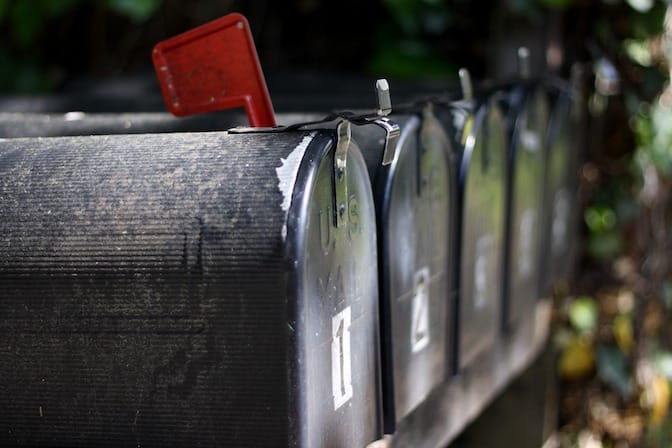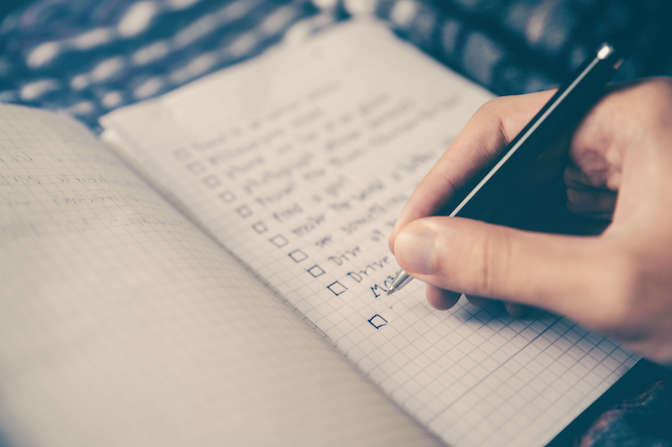So you've read thousands of job ads and picked out the ones that sound like they're tailor-made for you.
But ask yourself this: is your resume tailor-made for them?
If the answer is no, stop what you're doing. Before sending off your application hoping to get a job interview, you need to make sure you have an effective resume.
We're talking about the sort of resume that positively screams “don't waste time reading those other applications, you've already found the right person for the job”!
Luckily, you've come to exactly the right place. Welcome to our practical guide to writing the perfect resume quickly and easily!
So what are you waiting for?

Here's what you will learn in this guide:
1 – Resume basics. In other words, all the essential information your resume absolutely must contain. If you want to build high you need solid foundations!
2 – How to write a resume. Once you've seen what information to put in your CV, you'll want to know how to present it. Give your resume a makeover and learn how to avoid making presentation errors (e.g. spelling, formatting and layout).
3 – Amazing Secrets For Getting Hired. OK, so we may not have any earth-shattering secrets to reveal. But what we can offer are some great advanced tips!
Imagine you're doing an intensive course to learn a new sport. How would you go about it?
Probably you would start with the basics, then find out how to put them into practise, and finally learn some advanced techniques and the ‘tricks of the trade'.
This step-by-step article is set out in the same way. And it really couldn't be easier to follow!
So, are you ready to set off?

The Perfect Resume - Basic Purpose
Think of your CV [abbreviation for Curriculum Vitae] as your passport to work: a document setting out in a limited amount of space your education and training, your experience, and the skills you can offer an employer.
Obviously, it also needs to tell potential employers how they can contact you.
But what is the actual purpose of a resume?
And why does it need to be perfect?
The main purpose of a resume is to persuade a company to call you for an interview. Its job is not necessarily to get you hired - but it does need to get you an interview.
It needs to be perfect because, out of all the candidates who have sent in an application, we want the company to call you.
Later, we'll look at how to achieve this, step-by-step.
But first of all it's important to understand that writing a resume does not mean telling your life story on a couple of sides of A4.
Don't forget:

A résumé is a business card saying who you are from a professional perspective.
What it is not is the transcript of a session on the psychiatrist's couch, in which you talk about everything that ever happened to you since the age of two!
The job of a resume is to describe your main professional qualities and should contain only the information strictly needed to do that.
Okay, great. Now that's clear, let's look at the basic rules for writing an effective CV!
The 7 Key Elements of a Resume [The Basics of a CV]
Any resume, regardless of the model you decide to use (more on this later), contains a number of key pieces of information.
The 7 pieces of essential information your resume must contain are:
- Your contact details
- A professional-looking photo (but only for certain types of work)
- A personal statement
- Your work experience
- Your education
- Your skills and competencies
- Your hobbies and interests
Let's take a look at them.

#1 – Never Mess Up the Contact Details in Your Resume
Your contact details - name and surname, address, telephone number and e-mail - are, to put it mildly, absolutely indispensable!
Basically, if they're not in your resume, you're wasting your time.
Remember the reason why you've spent hours putting together your resume: you want people to contact you. It follows that you need to make sure your contact details are right.
THERE ARE NO TWO WAYS ABOUT IT.
Get it?
A word about your email address. You're looking for work, so that email account with the silly nickname you set up when you were 13 probably isn't ideal.
The most reliable option is the classic name-plus-surname address, as it suggests you take a serious professional attitude to work!

“Should I include a link to my personal website?” I hear you say.
Before deciding, ask yourself this:
Doe the website add anything to what you've already put in your CV? Is it important for the position you are looking for?
If the answer to these questions is no, then don't bother. A Graphic Designer needs a showcase for his or her work but this is the exception rather than the rule.
Clear? So go ahead.
#2 – How To Make your Resume 14 Times More Popular

Q: “Do I need to put a photo in my resume?”
The answer really depends on the country in which you live or are looking for work.
But wherever you are or want to work, consider this: a study by LinkedIn showed that profiles with a photo receive 14 times more views than profiles without a photo!
All well and good, you may say, but that doesn't apply to me because a resume isn't a social media profile.
Worry not: for those in doubt whether to include a photo in their CV or not, we have prepared an article explaining how to choose a professional-looking photo for your resume!
Okay, so now that you've cracked the photo dilemma, you're ready for the third key element of your CV!
#3 – Writing a Personal Statement For Your Resume: How To Make a Great First Impression

Everyone wants a CV that will make a great first impression, right?
Achieving that goal is easier than it might seem!
The key is to write yourself a personal statement:
This should be just 2 to 3 sentences long – ideally, say, no more than 5 lines – and should sum up everything that's special about you.
But while a personal statement may be just a few lines long, it's probably more difficult to get right than the rest of the resume put together. After all, just how do you condense everything you need to say into a just a few words?
Here's the solution.
Try thinking about how you would answer if you were asked to:
- Describe your strengths
- Speak about your career plans
- Talk about your future ambitions – i.e. the career goals you have set yourself
Try writing down the answers and then re-read them several times:
Each time you re-read, remove anything that strikes you as less relevant, until you gradually arrive at a final draft.
Examine the resulting statement from every point of view. Analyse and fine-tune it. Imagine that a recruiter will see just this section of your resume and that you need to convince him or her of your worth on the strength of your personal statement alone.

Truth be told, a personal statement is not considered one of the fundamental elements of a CV. But it is a good idea to write one.
Look at this way: you're not obliged to take a run up when you're doing the long jump. But if you don't take one …
...you can't complain if you don't jump as far as the competition!
#4 - Find Out How To Present Your Work Experience in Your CV
When describing your work experience in your resume, you need to provide the following minimum information:
- The position you held
- The company you worked for
- The address of your place of work (esp. town and country)
- The start and end dates of each position
But this alone doesn't tell us an awful lot about your work experience.
Think about it:
The reason you include your past work experience in your resume is to show not only what you did, but also what you learned, i.e. the skills and knowledge you acquired and the results you achieved.
To convey this, add a description and perhaps a list of the key characteristics of each position.
When you describe your experiences, use verbs of action that clearly tell the reader what your work actually consisted of.

Remember:
Show, don't tell.
Make a list of the results you achieved rather than your duties, and where possible use numbers instead of words!
For instance, "As a result of my work, sales increased " tells us almost nothing.
On the other hand, "Sales increased by 27% in the first quarter following my arrival at the company, thanks to a new appointments scheduling method that I introduced " will have recruiters wanting to hire you on the spot!
Once you've figured out how best to present the results you achieved in your past positions, we can move on to the next step!
#5 - Educational Background: How to Present Your Academic Qualifications in a Resume
The more work experience you have, the less you need to talk about your education in your resume.
That said, you do need to have some information in your CV about the qualifications you hold and any training you have completed.
You should include the following information as a minimum:
- The qualification(s) you obtained
- The educational institution from which you obtained them
- The start and finish date of each individual period of study – the year is important, but the day and month can be left out if not relevant

Everything else is optional, including the mark you achieved: it's up to you whether you include it or not.
But beware!
Decide carefully how much information you want to give, based on how important education is in your resume.
Since the space you have is limited, you don't want to waste it on information that isn't relevant!
Everything clear so far?
Great, let's move on to our sixth key point!
#6 - How to Present Your Skills in a Resume
You may well possess a vast range of skills and abilities, but it isn't possible to find room for them all: somehow, you need to decide what is important.
One useful rule of thumb might be to leave out anything you could imagine yourself boasting about at the bar!
It's easy, isn't it?

Let's see what information you really need to include.
1. Language and IT skills are indispensable
The importance of your language and information technology skills will vary in accordance with the kind of job you are looking for, but you should always include them in your resume.
The key issue here is being objective.
If you have specific qualifications, or have attended courses, then there's no problem, because your skills have been certified by an independent external body.
But if you are appraising your own skills, you need to be honest with yourself.
The bottom line?
Make that ruthlessly honest.
Remember that a practical test of your language skills might well form part of your interview... ...and if that is the case, there'll be no way of hiding what your actual level is!

Don't forget to that the ability to drive a vehicle is also considered a skill.
You should always find a space in your resume to indicate which vehicles you are licensed to drive and whether or not you own a car!
2. Additional Skills Or Abilities
As far as additional skills and abilities are concerned, it's usual practice to indicate your communication and organizational skills.
But a word of warning:
Don't just include these skills as a way of filling space. Try to think of real-life situations in which you used them, as one of the most common questions in an interview situation is:
"Can you give me an example of a time when you used this skill?"
Consider also how professionally relevant the situations you plan on using as examples are. For example, organizing an evening out with friends on Saturday night might not be enough to convince an interviewer of your ability to manage a team in a working environment.
Right, that's us done with the skills and abilities section.
All that's left now are your personal interests!
#7 – Here's How Selectors Evaluate the Personal Interests You List in Your Resume

And so we come to the last key bit of information: your personal interests and hobbies.
You may well be asking:
"Do I really need to put my hobbies in a CV? Surely my personal interests are of no interest!"
And to be honest, there's only one sensible criterion for deciding whether to include them in your Curriculum or not: usefulness.
That is, will the picture the company forms of you be influenced by what you do in your spare time? And, more importantly, will it be influenced in the right way?
Think about the kind of person the company is looking for and whether your hobbies and interests are a match for that type of person.
If they are looking for an energetic, dynamic person, then mentioning your unique collection of postage stamps is probably a waste of space, whereas your membership of a mountain climbing club is a card that is definitely worth playing.
All of your interests are potentially useful in relation to the circumstances. But think carefully about which to choose, because you won't get another chance!
We've now covered all of the key elements of a resume.
Before moving on, let's quickly recap on the main points!

The basic ingredients for a successful resume are:
- Personal and contact details (+ photo if necessary)
- Personal statement
- Work experience
- Education
- Skills and knowledge
- Hobbies and interests
Got that?
Perfect. Now it's time to move from theory to practice!
How To Write an Effective Resume [Practical Tips for CV Writing]

So far we've shown you how to make sure your resume contains all the key information.
But you can – and should – do more to stand out from the competition!
But what?
Well, now it's time to find out: we've divided our tips and guidelines into 7 thematic areas:
- Formatting
- Bullet points
- Typos and grammatical errors
- Number of pages
- The made-to-measure resume
- Using the right vocabulary
- Getting the format of your resume right
Applying these strategies will ensure every each part of your CV is written and designed in the best possible way.
So without further ado – let us proceed!
#1 - Formatting or How to Give Your Resume a Makeover
With a resume, you don't get much time to introduce yourself.
But whether you are given 6, 30 or 60 seconds, if you send out a CV that's badly formatted then you're heading straight for the waste paper bin.
It's a classic book-judged-by-its-cover scenario.

With competition getting tougher by the minute, the way a resume looks has become sufficient reason to discard an application with barely so much as a glance.
That's why you need to pay as much attention to the way your CV looks as you do to writing its content. Otherwise you'll find all your efforts will have been in vain.
The font you use to write your resume (your resume's “calling card”, if you will) has 4 variables:
- Style
- Size
- Colour
- Formatting
Let's look at each one in detail!
1. Find Out the Best Font Style to Use When Writing a Resume

The style is the way a font is designed.
There are two kinds of font style:
Serif and Sans Serif.
A "Serif" is a decorative line or embellishment added to the basic form of a letter.
Serif fonts are therefore fonts with a decorative style, while Sans Serif are essential, no-frills fonts.
The best type of font style for a CV are Sans Serif fonts, without embellishments.
Some of the most common Sans-Serif styles are Helvetica, Arial, Lucida Sans and Verdana. It could, however, be argued that these are a little too common, so you may want to try a slightly more unusual style. Just make sure that it is Sans-Serif!
Why?
There are two advantages in using a Sans Serif font:
- They help the selector read what you've written
- They help prevent the resume scanning software (programs that many large companies use to help them process the huge quantities of CVs they receive) from misreading the content of your Curriculum Vitae and discarding it
It's therefore best to select a font style that is as easy to read as possible for both humans and computer software.
Once you've decided, don't change mid-CV – use the same style all the way through.
2. Selecting the Right Font Size for Your Resume

Limited space is an unavoidable feature of the resume format. And there's nothing to be gained from attempts to get round the problem by reducing the font size.
The reason why is quite simple:
If your text is too small, recruiters won't be able to read it and will decline to consider your application. Which is a polite way of saying you're heading for the waste paper bin!
The optimum font size for a resume is from 10 to 12:
It all comes down to this:
Make sure the text is legible, but don't waste space using an excessively large font.
3. The Best Font Colour for a Resume

Professionalism should be your watchword here.
Unfortunately, this is not what you will convey if you use a different colour for every line of your CV.
Avoid using more than two colours: one is preferable, with black the best option.
If you decide to use another colour in addition to black, consider carefully how it will look printed in black and white, which in all likelihood is how the selectors will see it.
This doesn't mean you can't emphasize important aspects of your resume, though.
And you know what?
There are other ways of doing it besides the use of colour, as we will now see!
4. Emphasizing The Key Points Of Your Resume

You have three tools at your disposal for drawing attention to key information in your resume:
Bold, underline and italics.
Use these tools wisely, picking out the salient details in the text, to highlight your most important achievements, the positions you have held, your key strengths and abilities or the qualifications you hold.
But remember!
Be careful not to overdo it though: if you try to highlight everything…
...you'll end up highlighting nothing!
That completes our section on formatting. Let's move on to our next topic, bullet points.
#2 - Bullet Points: Your CV Will Be Discarded By One In Every Three Selectors If You Don't Use This Technique

List of skills are popular with selectors because they force candidates to condense their skills into a series of bullet points. This helps them immediately zoom in on what's relevant.
Show that you know how to use bullet points correctly: 20-line blocks of text don't suddenly get better just because you stick a bullet in front of them!
Make sure the bullet points of your Curriculum Vitae are brief, symmetrical (all the same distance from the margin and ideally the same number of lines long) and constructed the same way (e.g. if you start one with a verb, make sure they all start with a verb).
The most important part?
Focus in particular on the first three bullets:
Compile your points in order of importance, starting from the most relevant, as these are the ones the selectors will focus on.
#3 – Avoid Typos and Grammar Errors With These 3 Simple Steps

The spelling and grammar in your resume should be perfect.
End of story.
But fear not!
Following these 3 simple steps will help you weed out those unwanted errors:
- Read your resume over and over again carefully
- Read it from bottom to top. It might seem strange, but doing so will force your brain to focus on each individual word, thus increasing the odds of detecting typos
- Get somebody else to read it. You can try tricking your brain all you like, but if you've been working on your CV for hours you will know it back to front. With that in mind, a fresh pair of eyes will likely root out any errors you may have missed
And then, go on!
#4 – How Many Pages Should A Successful CV Have?
Your resume should be at most two sides of A4 long.
There are some circumstances where an exception can be made (for example, academic Curricula) but usually the rule is two.
And that really is the maximum length - in fact, the single-page resume has many advocates.
This is the space you have to play with. It's not a lot, so you need to use it as effectively as you can.
Deciding what to put in and what to leave out is one of the main challenges you face when preparing a CV. So rather than ducking the issue, work out how to overcome it!
Want to know the best way to come in under the two side limit?
Use a chisel!

Okay, so the tool you can see here is actually a plane, not a chisel, but the principle is the same:
Don't remove sections at random. Instead, gradually eliminate the parts you feel are least important …
...until finally you have managed to say everything you need to say in two pages!
Now read all of it, several times. Each time you re-read, look for an adverb that you don't really need, an adjective that could be taken out, a sentence you could rewrite using fewer words.
Get rid of all the excess until you are left with just the essential.
And you're good to go.
You'll see that you really don't need any more than two pages for an efficient and effective CV!
#5 - Making Your Resume “To Measure”

When preparing a resume and deciding what (and what not to) include, your sole guiding principle should be the made-to-measure CV.
Think a resume is something you prepare just the once - a one-size-fits-all affair you can use for any number of job offers - perhaps even for all the job offers you apply for?
Then think again.
The one-size-fits-all resume does not exist!
If you really want to get results, you need to prepare a tailor-made CV for each individual job offer.
Unsure how to go about it?
No need to worry.
The perfect template is staring you in the face…the job ad itself!

Use the text of the ad as a guide. It will make deciding what to focus on a whole lot easier.
The more a quality or skill you have meets the requirements set out in the ad, the more relevance it should be given in your resume.
Just make sure you don't overdo it. Your CV should be in line with the job ad, not identical to it!!
Right, all done sewing and stitching?
Great. But we're not finished with fashion quite yet…
#6 – Going With the Flow Is Never a Good Idea. Here's Why

We're talking fashion again, but this time, it's lexical rather than sartorial fashions we are interested in.
Given that a resume offers only a very limited amount of space to play with, it's important not to waste it using words with very little meaning.
What we mean by this is quite simple.
When choosing your vocabulary, go against the flow and refrain from using buzzwords.
Fitting in with a company's expectations doesn't have to mean resorting to clichés and jargon.
For instance, take the word “Creative”:
It goes without saying that companies are looking for creative people.
And you, of course, are very creative.
But are you really sure you're unable to convey this without using one of the three most commonly used words in professional profiles?
Quite apart from the fact that, in real life, people almost never talk like this.
Excellent, we're now almost at the end of the section on preparing an effective CV:
One more point on getting the format of your resume right, and that just leaves our advanced tips!
#7 – Everything You Need to Know About resume Formats
A resume can essentially be delivered in two different formats – paper or electronic.
If you decide to deliver it by hand, or send it by traditional post, you need to decide what paper to print it on.
Of course, you could decide to print the resume on a bar of chocolate …

...but only if you're looking for work in a company that makes chocolate.
Otherwise, professionalism should be your watchword.
Your CV should be elegant, professional, and serious – in one word: effective.
All of which can only mean one thing:
White paper. End of story.
If you decide to send your resume by email, the format you use is of fundamental importance.
Don't run the risk of hours of work going to waste because of a compatibility issue between software programs.
Instead, once you're pleased with how your CV looks, save it in PDF format.
The PDF file format allows a document to be viewed on any device exactly as it was saved. Which is precisely what you want to achieve!
And that's it as far as our advice on the formal aspects of your resume is concerned....
...but don't go anywhere just yet. Before starting on your Curriculum Vitae, let's look at some advanced tips that can turn a good resume into a great one!
5 Life-saving Tips for Writing a Professional Resume [The Perfect CV and Beyond]

Now that we've seen the basics and the practical ins-and-outs of Curriculum Vitae writing, let's move on to the advanced techniques.
Below we have selected five life-saving tips that will ensure you have a truly professional CV!
#1 - Beyond The Resume - Writing a Cover Letter
A resume alone is not enough.
This might come as a surprise, but if you want to improve your CV you may need to take things a step further.
How exactly?
The answer is to prepare yourself a cover letter.
Not just any old two-line cover letter though, but a first class one with all the trimmings.
Sound complicated?
It really isn't…
...once you know how!

We want to give this important topic the full and thorough treatment it warrants.
That's why we’ve prepared a detailed article on how to write a professional cover letter!
#2 - Turning The Gaps in Your Resume into Strengths
In an ideal career, when one job ends another starts.
A lucky few will be able to list an unbroken sequence of positions on their CV.
But real life doesn't always work that way.
All kinds of situations can occur during a career that all have one thing in common: they create gaps in your employment history.
Meaning your professional timeline may look about as smooth as a lunar landscape...

...but fear not - we have the solution for you!
You simply need to work out how to explain the interruptions in your career.
Here's how:
- If the interruption is a short one, you can hide it easily – just indicate the start and end year of the position and a gap of a few months will magically disappear.
- If the interruption is a more substantial one - or if you simply don't want to hide it - be honest, and explain what you were doing!
Perhaps you travelled, did voluntary work or dedicated time to your family.
Regardless of the situation, this was not time spent doing nothing. Rather, these were periods of personal growth from which you will have taken something important.
Try to find a way of communicating the positive aspects of these interruptions and you will have transformed that gap in your career into a strength.
...and once that's done you'll be ready for the next tip!
#3 – Keep Improving Your CV, Day After Day

Keep on showing your resume to as many people as possible.
This may not sound like a very useful tip. But it really is worth its weight in gold. This simple habit will help you improve your CV day after day.
How?
Everyone has their own point of view. And what's perfect for one person might strike another as in need of improvement.
Preparing a resume is a question of continuous improvement and revision.
Take on board every suggestion you are given as they will help you improve for next time.
But just who should you turn to for the best advice on writing a CV?
The answer is, quite simply, everybody:

- Your friends, who may have a clearer - and definitely more objective - idea of what your skills and abilities are than you do
- Your family and relatives, who will have a different perspective on you from everybody else
- People who work in your sector, who may have acquired a certain experience of that field and its own special dynamics
- Plus, obviously, selectors, who see resumes and Curriculum Vitae day in day out - and probably even dream about them!
And if this advice doesn't prove sufficient, you can always seek advice from professionals:
There are specialist agencies out there offering resume writing and revision services. If you are still unsure, enlisting their help might be a good idea.
But we've been speaking for so long about what to write in your CV that we've forgotten one crucial point:
There are some topics that shouldn't be dealt with in a resume!
#4 - 2 No-go Topics That Could Ruin Your Resume
There are two things that you should NEVER write about in your CV.
Ever.
So what are they?
Well, let's see, shall we?
1. Salary

Never say in your CV how much you were paid in your last job or how much you expect to be paid in your new job!
According to an unspoken rule, the question of salary should only be broached at an advanced stage of the selection process.
And It's safe to say that the resume stage is definitely far too early. So leave it out!
2. Speak negatively about your former colleagues or bosses
Another topic you should steer clear of is any negative comments about your previous places of work.
It doesn't matter how useless your boss was, or how lazy your colleagues were, or even how rubbish the product was - your resume is about you and what you have achieved.
Always use positive – or at worst neutral - tones, when you write, and talk, about your past work experiences.
Nobody is going to hire someone who has shown themselves quite so willing to bad mouth former colleagues and managers!
And finally...
#5 - Resume Model - Original or Traditional?
There is no resume model so utterly perfect that it can be copied blindly. Meaning in theory you could write yours in the order of your choosing.

Assuming that you include all of the key information (you would be wasting your time if you sent off a CV that didn't have any contact details!) then you can pretty much decide for yourself the order you want to present it in.
The standard order is, as we have already seen:
- Personal/contact details (and photo)
- Personal statement
- Work experience
- Education
- Skills and competencies
- Personal interests and hobbies
You can alter that order if you wish, but remember that originality cuts both way:
Going against convention will make you stand out from the crowd, but not necessarily in the way you want it to!
Now It's Your Turn
Congratulations, you've made it to the end! 🙂
You've read everything you need to know about preparing your Professional Curriculum Vitae:
So what now?
Well now it's your turn:
Put into practice everything you have read here…
...and then you will be ready to send out your “extra special” resume in response to all of the job ads you find on Jobted!



![100 Job Interview Questions and How To Answer Them [The Definitive List]](https://au.jobted.com/blog/wp-content/uploads/job-interview-questions-answers-200x200.jpg)
![Thank You Letter After a Job Interview [Best Tips and Examples]](https://au.jobted.com/blog/wp-content/uploads/thank-you-letter-interview-200x200.jpg)
![Example Cover Letter for Resume [2 Templates, 10 Tips and 10 Mistakes]](https://au.jobted.com/blog/wp-content/uploads/example-cover-letter-resume-200x200.jpg)